
Johannes Lingelbach stands as a significant figure in the rich tapestry of Dutch Golden Age painting. Active during the 17th century, a period of extraordinary artistic production in the Netherlands, Lingelbach carved a distinct niche for himself. Born in Germany but spending his formative and productive years primarily in Amsterdam, he became renowned for his captivating depictions of Italianate landscapes, bustling marketplaces, and lively harbor scenes. He skillfully blended the meticulous detail characteristic of Northern European art with the warm light and classical ambiance of Italy, a country that profoundly shaped his artistic vision during a crucial period of travel and study. As a prominent member of the second generation of Bamboccianti painters, Lingelbach contributed significantly to this genre, while also excelling as a staffage painter, collaborating with several leading landscape artists of his time. His work offers a fascinating window into the cross-cultural artistic exchanges of the era and the enduring allure of Italy for Northern artists.
Early Life and Artistic Beginnings
Johannes Lingelbach was born in Frankfurt am Main, Germany, in 1622. His origins, however, were closely tied to the Netherlands. His father, David Lingelbach, was a German technician or merchant who later found success in Amsterdam. His mother, Agnes Jans, hailed from the Netherlands. This familial connection likely facilitated the family's relocation to Amsterdam in 1634, when Johannes was about twelve years old. Amsterdam, at this time, was a burgeoning metropolis, the vibrant heart of the Dutch Republic's global trade network and a major center for the arts.
The Lingelbach family settled in the Jordaan district, a lively area known for its artisans and tradespeople. David Lingelbach operated a form of entertainment establishment, described as a pleasure garden or labyrinth, also called "The Jordaan." Notably, this establishment featured automated mechanical figures, likely depicting mythological or biblical scenes accompanied by music, showcasing an early family connection to visual spectacle and perhaps influencing the young Johannes's interest in narrative and composition. In 1636, following his father's footsteps in some capacity, Johannes reportedly inherited or took over aspects of this enterprise.
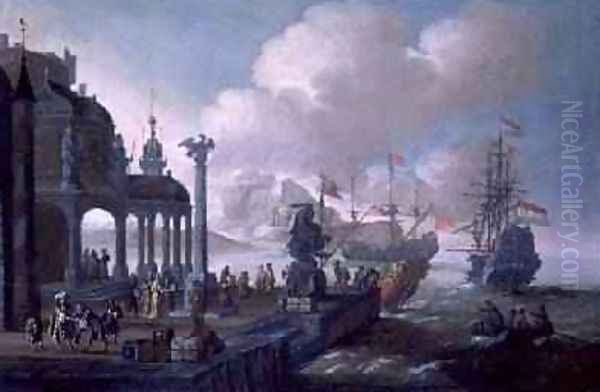
While details of his earliest artistic training remain somewhat scarce, it is certain that Lingelbach received his foundational education as a painter in Amsterdam. The city teemed with studios and masters, offering ample opportunity for aspiring artists. Though his specific teacher is not definitively recorded, the prevailing styles and techniques of Amsterdam's art scene would have formed the bedrock of his initial development. He likely honed his skills in drawing and painting, absorbing the Dutch emphasis on realism, detailed observation, and the skillful rendering of textures and light, even before his transformative journey south. A brief return to his birthplace in 1642 saw him gain Frankfurt citizenship, a formality perhaps, before embarking on the travels that would define his artistic identity.
The Italian Sojourn: Rome and the Bamboccianti
In 1642, at the age of twenty, Johannes Lingelbach embarked on a journey that was almost a rite of passage for ambitious Northern European artists: he traveled south, first likely through France, and then to Italy. He would spend approximately eight years abroad, with a significant portion of this time, possibly from around 1644 until 1650, spent in Rome. Italy, particularly Rome, was considered the ultimate finishing school, the repository of classical antiquity and Renaissance mastery, offering unparalleled opportunities for study and inspiration.
During his time in Rome, Lingelbach fell under the influence of a distinctive group of predominantly Dutch and Flemish genre painters known as the "Bamboccianti." This group coalesced around the pioneering figure of Pieter van Laer (1599–c. 1642), a Dutch painter nicknamed "Il Bamboccio" (meaning "ugly doll" or "puppet," possibly referring to his physical appearance). Van Laer specialized in depicting the everyday lives of the common people in and around Rome – peasants, street vendors, artisans, travelers – set against recognizable or evocative Roman backdrops. His work, and that of his followers, was characterized by its realism, often earthy humor, and focus on anecdotal scenes, standing in contrast to the grand historical or religious subjects favored by the Italian academic tradition.
Lingelbach became a leading figure among the second generation of Bamboccianti artists who were active in Rome after Van Laer's departure or death. He embraced their subject matter, frequently painting bustling Roman piazzas, lively markets, blacksmith shops, and scenes of travelers resting or soldiers carousing. While influenced by Van Laer's thematic choices, Lingelbach developed his own distinct approach. His compositions are often more complex and elegantly structured, his figures rendered with greater refinement, and his palette, while capable of capturing the warmth of Italian light, often retained a cooler, silvery tonality characteristic of Dutch painting.
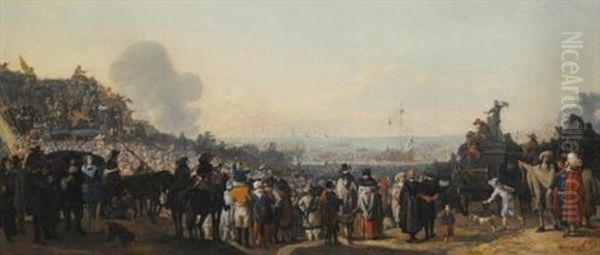
His time in Italy was not solely focused on genre scenes. Lingelbach also demonstrated a keen interest in architectural representation. Sources suggest he may have studied or collaborated with Viviano Codazzi (c. 1604–1670), an Italian painter renowned for his architectural views (vedute) and illusionistic ceiling paintings (quadratura). This interaction likely honed Lingelbach's ability to depict buildings and urban spaces accurately and convincingly, incorporating classical ruins and contemporary Roman architecture into his compositions with considerable skill. This fusion of lively genre figures with carefully rendered architectural settings became a hallmark of his Italianate works.
Return to Amsterdam and Mature Style
Around 1650, Johannes Lingelbach concluded his extended stay in Italy and made his way back north, eventually resettling in Amsterdam by 1653. He would remain in this bustling artistic hub for the rest of his life, establishing himself as a respected and successful painter. His experiences in Italy provided him with a rich repertoire of subjects and a distinctive style that appealed to Dutch collectors, who often favored depictions of sunny, idealized Italian landscapes and scenes as an escape from the often-greyer Northern climate.
Upon his return, Lingelbach's mature style solidified. It represented a sophisticated synthesis of his Dutch training and his Italian experiences. He retained the Dutch penchant for careful observation and detailed execution but applied it to subjects imbued with Mediterranean light and atmosphere. His compositions became known for their clarity, balanced arrangement of figures and architecture, and skillful handling of perspective. While associated with the Bamboccianti, his depictions of Italian life often possessed a greater elegance and less of the rustic earthiness found in the work of Pieter van Laer or some of his followers like Michelangelo Cerquozzi.
In 1653, Lingelbach married Tietje Hendrix Boussi in Amsterdam. The couple went on to have a large family, with records indicating nine children. This period marked his establishment not just as an artist but as a settled member of Amsterdam society. Beyond his painting, Lingelbach was also proficient as an engraver and etcher, producing prints that further disseminated his compositions. His standing within the artistic community is also evidenced by his occasional role as an appraiser or arbiter in disputes concerning artworks, indicating the respect he commanded among his peers. He continued to paint prolifically, developing his signature themes and collaborating with other artists until his death in Amsterdam in 1674, at the relatively young age of 52.
Master of Diverse Genres
While best known for his Italianate scenes, Johannes Lingelbach demonstrated proficiency across a range of subjects, showcasing his versatility as an artist. His oeuvre reflects the diverse tastes of the Dutch art market and his own varied interests.
Italianate Landscapes and Cityscapes
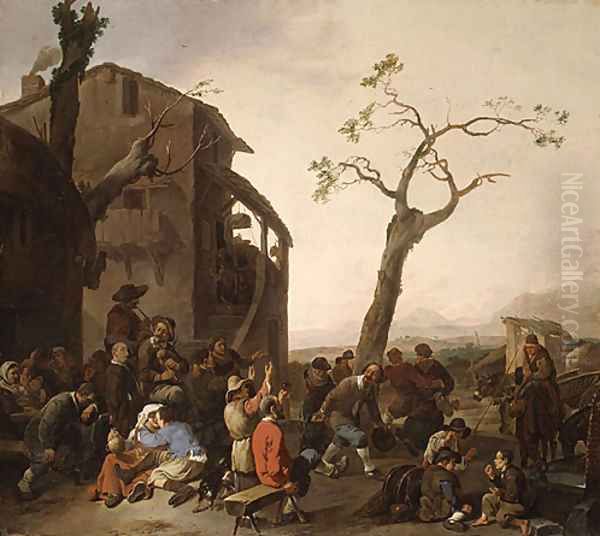
The core of Lingelbach's reputation rests on his Italianate landscapes and cityscapes. These works capture the allure of Italy through a Northern European lens. He frequently depicted imagined or composite views of Rome, often incorporating famous landmarks like the Piazza Navona or classical ruins alongside generic Italianate buildings. Works such as Market in Piazza Navona or The Blacksmith in Piazza Navona exemplify this genre. They are populated with numerous small figures engaged in various activities – trading goods, conversing, tending to animals – creating a sense of vibrant street life. Lingelbach masterfully balanced these detailed figures with the architectural setting, using light and shadow to create depth and atmosphere, often bathing the scene in a warm, golden Italian light that contrasted with the typical Dutch landscape palette. These paintings were not intended as topographically exact records but rather as evocative impressions of Roman life, catering to the desires of Dutch patrons for souvenirs of the sunny South.
Bustling Harbors and Markets
Closely related to his cityscapes are Lingelbach's numerous depictions of Mediterranean harbor scenes and bustling markets. These paintings allowed him to combine his skills in rendering architecture, figures, and even ships. Works like Mediterranean Harbour (Mauritshuis) showcase busy quaysides filled with merchants, sailors, stevedores, and travelers from various lands, sometimes including exotic figures like Levantine traders in turbans, adding a touch of orientalism popular at the time. Crates, barrels, and bales of goods clutter the foreground, testifying to the commercial activity. These scenes often feature classical ruins or imposing fortifications overlooking the harbor, blending realistic observation with picturesque elements. The complex interplay of figures, the detailed rendering of ships' rigging, and the expansive views towards the sea demonstrate Lingelbach's compositional skill and his ability to manage intricate scenes effectively.
Military Scenes and Historical Events
Lingelbach also turned his hand to military subjects and depictions of contemporary historical events. Battle Scene (Metropolitan Museum of Art) is a prime example, showcasing cavalry engagements with dynamic action and careful attention to armor and weaponry, likely influenced by the popular battle painter Philips Wouwermans. More specific historical events were also recorded, such as the significant paintings documenting the Restoration of the English monarchy: The Departure of Charles II from Scheveningen and The Journey of Charles II from Rotterdam to The Hague (both Mauritshuis). These works required not only the skillful arrangement of large numbers of figures, horses, and carriages but also a degree of portraiture and attention to ceremonial detail, demonstrating Lingelbach's capacity to handle large-scale, narrative compositions documenting important moments of his time.
Genre Elements and Peasant Scenes
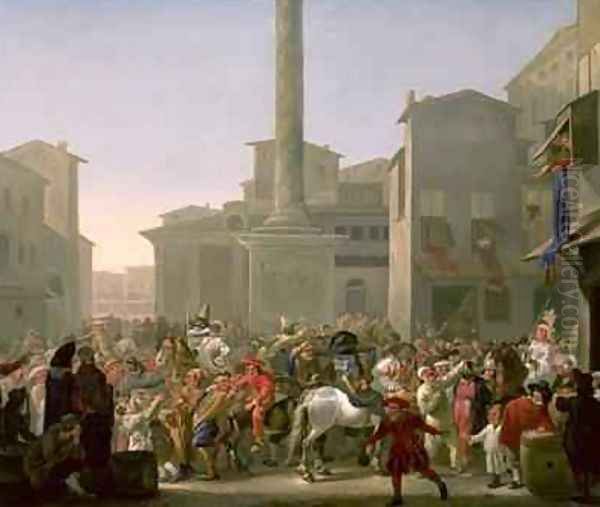
While often set within grander landscape or architectural contexts, elements of genre painting pervade Lingelbach's work, stemming from his Bamboccianti roots. He depicted everyday activities, market interactions, and moments of leisure. Occasionally, he focused more specifically on rural or peasant life, as seen in works like Peasant Dance (Metropolitan Museum of Art). Although his figures are generally more refined than those of the earlier Bamboccianti, these paintings still capture the energy and character of common life, contributing to the breadth of his subject matter and reflecting the Dutch market's appetite for genre scenes alongside more idealized Italianate views.
Collaboration and the Art of Staffage
A particularly interesting aspect of Johannes Lingelbach's career, and a common practice in the highly specialized Dutch art market of the 17th century, was his work as a staffage painter. Staffage refers to the figures and animals added to a landscape painting, often by an artist other than the one who painted the landscape itself. Artists frequently specialized, with some excelling at landscapes, others at architecture, animals, or human figures. Collaboration allowed painters to combine their strengths, producing a final work of higher overall quality or specific appeal.
Lingelbach was highly sought after for his skill in painting lively, well-drawn figures and animals that could animate the landscapes created by his contemporaries. He frequently collaborated with some of the leading Dutch landscape painters of his day. Perhaps his most famous collaborations were with Meindert Hobbema (1638–1709), one of the great masters of Dutch landscape painting. Lingelbach added the figures that populate some of Hobbema's serene woodland scenes and village views, lending them narrative interest and scale.
He also provided staffage for Jan Wijnants (c. 1632–1684), another prominent painter known for his dunescapes and Italianate landscapes. Lingelbach's figures complemented Wijnants's expansive settings. Other landscape specialists known to have utilized Lingelbach's talents for staffage include Jan Hackaert (1628–1685), known for his avenues of trees and Italianate views, and Frederick de Moucheron (1633–1686), who specialized in idealized Italianate and French-style landscapes.
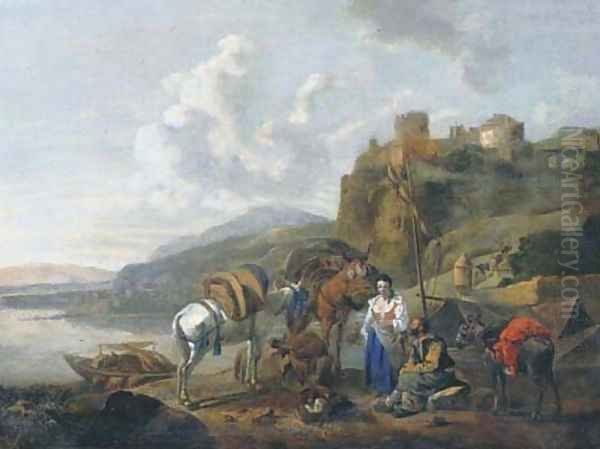
Lingelbach's own style was influenced by contemporaries like Philips Wouwermans (1619–1668), a hugely popular painter celebrated for his depictions of horses, cavalry battles, and elegant hunting parties. While primarily an influence, the dynamic figures and animals in Wouwermans' work likely informed Lingelbach's approach to staffage. Furthermore, Lingelbach worked within a broader context of Dutch Italianate painters, many of whom also traveled to Italy and specialized in similar themes or engaged in collaborations. Figures like Nicolaes Berchem (1620–1683) and Karel Dujardin (c. 1622–1678) were also prominent Italianate painters and skilled staffage artists, sometimes competing with Lingelbach for commissions. Other notable Italianate contemporaries include Jan Both (c. 1618–1652), Jan Asselijn (c. 1610–1652), Jan Baptist Weenix (1621–c. 1660), and Adriaen van de Velde (1636–1672), the latter being another highly regarded staffage specialist. This network of influence and collaboration highlights the interconnectedness of the Amsterdam art scene and Lingelbach's respected position within it.
Artistic Legacy and Reception
Johannes Lingelbach's contribution to Dutch Golden Age painting lies primarily in his successful fusion of Northern European detail with Italianate themes and atmosphere. As a key figure among the second generation of Bamboccianti, he helped popularize scenes of Roman street life and Mediterranean harbors among Dutch audiences, translating the Italian experience into a format that resonated with Northern tastes. His work provided patrons with evocative glimpses of a sunnier, classical world, often imbued with lively narrative detail.
His skill in rendering figures and architecture made him not only a successful independent artist but also a valued collaborator. His staffage work enhanced the paintings of major landscape artists like Hobbema and Wijnants, demonstrating the importance of specialization and cooperation within the 17th-century art world. Through these collaborations, his influence extended even into works primarily credited to others.
During the 18th and 19th centuries, Lingelbach's paintings were highly esteemed by collectors, particularly those who appreciated the picturesque qualities of Italianate scenes and the technical refinement of Dutch Golden Age art. His works entered numerous prestigious collections across Europe. However, like many Bamboccianti and Italianate painters, his reputation experienced a relative decline in the early 20th century, as art historical tastes shifted towards the more purely "Dutch" realism of artists like Rembrandt or Vermeer, or the more dramatic landscapes of Jacob van Ruisdael. The Bamboccianti style was sometimes criticized as being derivative or overly focused on anecdote.
In more recent decades, there has been a renewed appreciation for the Dutch Italianate painters and the Bamboccianti, including Lingelbach. Art historians now recognize the significance of the artistic exchange between North and South, and the unique aesthetic achievements of artists who navigated these cultural currents. Lingelbach is acknowledged for his technical skill, his compositional elegance, and his role in shaping a particular vision of Italy that held enduring appeal for centuries. His ability to populate diverse scenes, from Roman markets to Dutch historical events, with convincing and lively figures secures his place as a versatile and important master of his time.
Market Presence and Collections
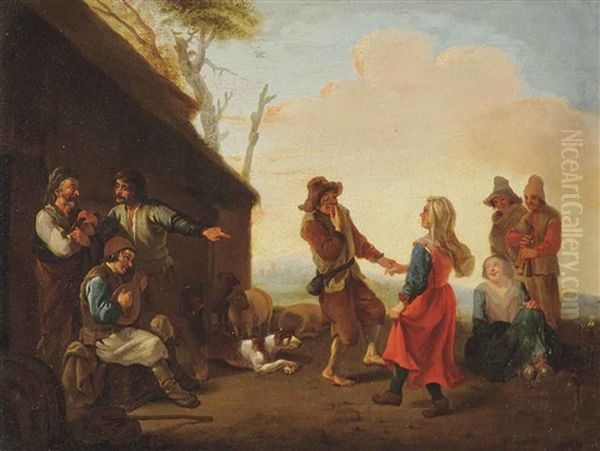
Johannes Lingelbach's works continue to be appreciated in the art market and are held by major museums worldwide. His paintings appear periodically at auction, reflecting a steady interest among collectors of Old Master paintings. Auction results indicate a range in value, depending on the size, subject matter, condition, and provenance of the work.
Recent auction estimates provide a snapshot of his market standing. For instance, smaller landscapes or genre scenes might be estimated in the range of €800 to €6,000, as seen in sales from 2022 to 2024 featuring works like Roman market scenes or generic landscapes. More significant or well-preserved works, particularly characteristic harbor scenes or complex cityscapes like those depicting the Piazza Navona, can command higher estimates, potentially reaching €6,000–€8,000 or more, although final sale prices can vary significantly based on bidding interest and market conditions.
Lingelbach's importance is cemented by the presence of his works in prominent public collections. The Mauritshuis in The Hague holds several key paintings, including the historically significant The Departure of Charles II from Scheveningen and The Journey of Charles II from Rotterdam to The Hague, as well as a characteristic Mediterranean Harbour. The Rijksmuseum in Amsterdam, the national museum of the Netherlands, also houses important examples of his work.
Internationally, his paintings can be found in major institutions. The Kunsthistorisches Museum in Vienna holds his vibrant Carnival in Rome. The Metropolitan Museum of Art in New York possesses works such as Battle Scene and Peasant Dance. Other prestigious museums like the National Gallery in London, the Louvre in Paris, and the Hermitage Museum in St. Petersburg also include paintings by Lingelbach in their collections. The recent placement of three Lingelbach works on permanent loan to the Hunno State Museum further indicates the ongoing relevance and desirability of his art for museum collections seeking to represent the breadth of Dutch Golden Age painting. This widespread institutional presence ensures that Lingelbach's art remains accessible for study and appreciation by the public.
Conclusion
Johannes Lingelbach remains a compelling figure within the Dutch Golden Age, an artist whose career successfully navigated the cultural and stylistic currents between Northern Europe and Italy. His journey south and immersion in the world of the Bamboccianti profoundly shaped his art, equipping him with a repertoire of Italianate subjects – bustling piazzas, sunlit harbors, lively markets – that he rendered with Dutch precision and refinement. He masterfully blended observed reality with picturesque invention, creating scenes that captivated his contemporaries and continue to engage viewers today.
Beyond his independent work, Lingelbach's role as a sought-after staffage painter highlights his exceptional skill in depicting figures and animals, and underscores the collaborative nature of the 17th-century art world. His contributions enriched the landscapes of masters like Meindert Hobbema, demonstrating his versatility and the high regard in which his peers held him. Though his fame may have fluctuated with changing art historical tastes, his technical prowess, compositional elegance, and his unique position as a mediator between Dutch realism and Italianate charm secure his enduring significance. Johannes Lingelbach's paintings offer a vibrant window onto the world of the 17th century, capturing the allure of distant lands and the richness of everyday life with enduring skill and appeal.